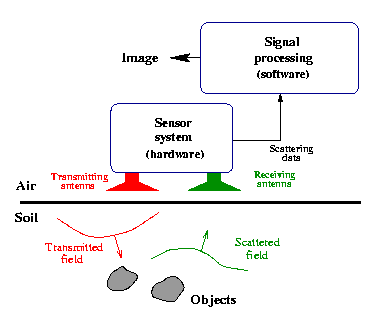The GPR Research Team
The GPR research at EMI was initiated by Peter Meincke. The research team is part of the Antenna and Electromagnetics Group at the Department of Electromagnetic Systems. The following persons are currently involved in the project:
- Peter Meincke (Associate professor, head of the GPR research project)
- Olav Breinbjerg (Associate professor)
- Oleksiy S. Kim (Assistant professor)
- Xianyao Chen (Assistant professor)
- Hans-Rudolph Lenler Eriksen (Ph.D. student)
Funding
The GPR research project is funded by the talent project program under the Danish Technical Research Council (STVF) until the end of 2003.
Background 
A ground penetrating radar (GPR) is the designation for a device that uses electromagnetic waves to detect objects such as pipes, cables, mines, and barrels buried under the surface of the earth. The GPR is usually situated close to the interface that separates air from soil. The transmitting antenna of the GPR emits an electromagnetic field that is transmitted into the soil where it interacts with the buried objects. This interaction results in a scattered field which is measured by the receiving antenna of the radar. By changing the location of the radar on the interface and recording the output of the receiving antenna as a function of time (or frequency) and radar location, one obtains the scattering data. From the scattering data information about the buried objects can be obtained by signal processing.
The signal processing strategy applied to the scattering data depends on the type of information required about the buried objects. Clearly, the signal processing strategy with the highest potential is the one that utilizes information about the underlying physics of the problem, that is, the electromagnetic scattering process described above. Such physics-based signal processing is referred to as electromagnetic inverse scattering . Although GPR has been subject to intensive industrial and academic research for many years, the signal processing of the major part of the commercially available GPRs is still not based on inverse scattering. Even though the hardware of such commercial GPRs usually is extremely well designed, the overall performance of the GPR is limited due to the application of nonphysics-based signal processing. The optimum GPR is only achieved by using well-designed hardware along with physics-based signal processing, that is, electromagnetic inverse scattering.
The GPR Research Project
In September 1998 a research project on application of electromagnetic inverse scattering to GPR was initiated at the Department of Electromagnetic Systems. The main goal is to obtain 3-dimensional quantitative images of the objects buried in the soil from GPR scattering data. A quantitative images means that it reflects physical quantities. In the GPR case these physical quantities are the permittivity and the conductivity (the permeability is assumed constant and equal to that of free space). Hence, a quantitative image does not only give information about the shape and location of a buried object but it also serves as a means for object classification. The project involves aspects of electromagnetic field theory, antenna theory and antenna design, numerical and mathematical analysis, and signal processing. Some of the issues to be addressed in the research project are
- Electromagnetic forward scattering from buried objects of arbitrary shapes and materials. This involves exact solutions, based on integral equations, as well as approximate solutions, based on, e.g., the Born approximation, the extended Born approximation, and the physical optics approximation.
- Electromagnetic modeling of radiation from antennas located close to the air-soil interface.
- Principles for measurements of characteristics of antennas located close to the air-soil interface.
- Design of GPR antennas.
- Electromagnetic inverse scattering. We address inversion in a non-linear as well as in a linear framework. The latter involves mainly diffraction tomography and synthetic aperture radar techniques.
- Experimental GPR setup.
Publications
Papers on electromagnetic inverse scattering and diffraction tomography with application to ground penetrating radar imaging:
- P. Meincke, "A 2.5-D diffraction tomography inversion scheme for ground penetrating radar," in Proceedings of IEEE Antennas and Propagation Society International Symposium, Orlando, USA, pp. 2132-2135, July 1999.
- G.A. Tsihrintzis, P. Meincke, and A.J. Devaney, "Buried object detection and location estimation from electromagnetic field measurements," IEEE Trans. Antennas Propagat., vol. 47, no. 11, pp. 1742-1744, Nov. 1999.
- T. Hansen and P. Meincke, "Inversion scheme for ground penetrating radar that takes into account the planar air-soil interface," IEEE Trans. Geosci. Remote Sensing, vol. 38, no. 1, pp. 496-506, Jan. 2000.
- P. Meincke, "2.5-D far-field diffraction tomography inversion scheme for GPR that takes into account the planar air-soil interface," Proceedings of IEEE Antennas and Propagation Society International Symposium, Boston, USA, pp. 662-665, July 2001
- B. Polat and P. Meincke, "Ground penetrating imaging of buried metallic objects," Proceedings of IEEE Antennas and Propagation Society International Symposium, Boston, USA, pp. 264-267, July 2001.
- P. Meincke, "Linear GPR inversion for lossy soil and a planar air-soil interface", IEEE Trans. on Geoscience and Remote Sensing, vol. 39, no. 12, pp. 2713-2721, December 2001.
- P. Meincke and O. Kim, "Accurate Antenna Models in ground penetrating radar diffraction tomography," Proceedings of the IEEE Antennas and Propagation Symposium, San Antonio, Texas, pp. 306-309, June 2002.
Papers on electromagnetic forward scattering of buried objects:
- J. Troelsen, P. Meincke, and O. Breinbjerg, "An investigation of the extended Born approximation at high frequencies for ground penetrating radar imaging," Proceedings of the International Conference on Electromagnetics in Advanced Applications (ICEAA), Torino, Italy, pp. 71-74, Sept. 1999.
- J. Troelsen, P. Meincke, and O. Breinbjerg, "Frequency sweep of the field scattered by an inhomogeneous structure using methods of moments and asymptotic waveform evaluation," Proceedings of IEEE Antennas and Propagation Society International Symposium, Utah, USA, pp. 1830-1833, July 2000.
- T.B. Hansen and P. Meincke, "Efficient calculation of scattering from a buried circular cylinder," Proceedings of the 9th international conference on ground penetrating radar, Santa Barbara, California, pp. 279-284, May 2002.
- T.B. Hansen and P. Meincke, "Scattering from a buried circular cylinder illuminated by a 3-D source," Radio Science, vol. 37, no. 2, March-April 2002.
[Back to Research projects]